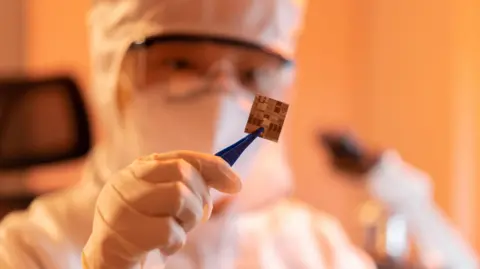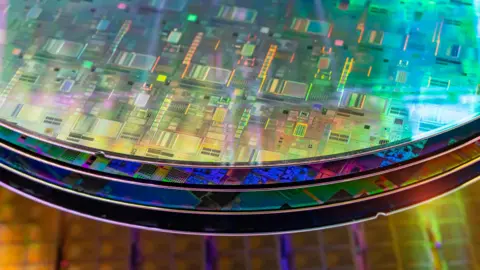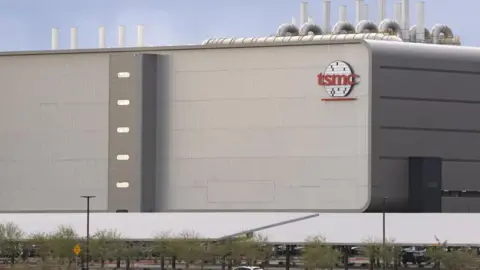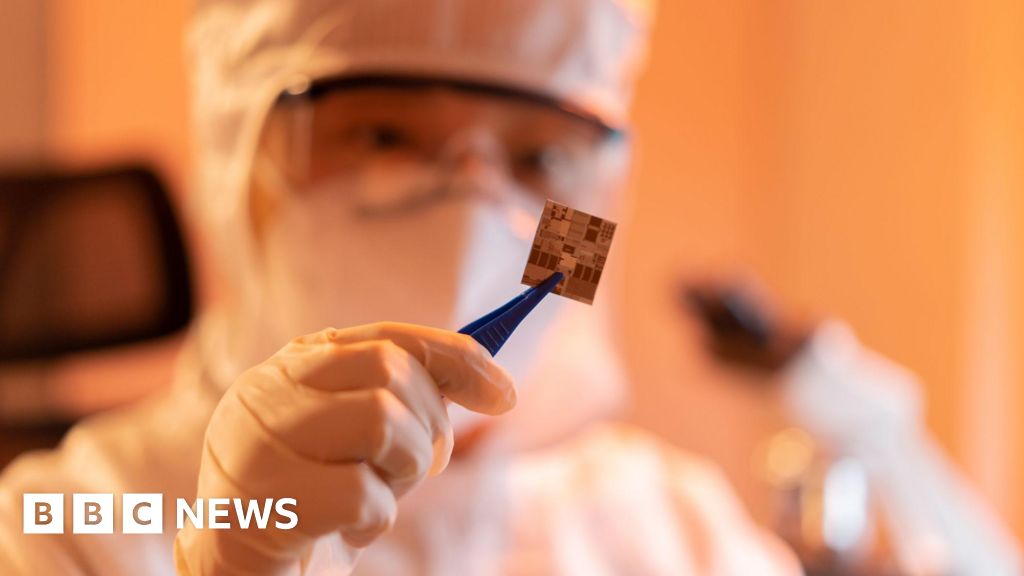Expertise reporters
 Getty Photographs
Getty PhotographsUS President Donald Trump has stated he plans to introduce 100% tariffs on semiconductor imports.
The tiny chips energy a spread of various units and are integral to trendy know-how and the worldwide economic system.
Whereas some semiconductor producers may very well be spared from the taxes, they could nonetheless affect the tech business and will push up the worth of some merchandise.
What’s a semiconductor and the way are they used?
Semiconductors have enabled a slew of contemporary units – from smartphones and laptops to online game consoles, pacemakers and photo voltaic panels.
Typically known as microchips or built-in circuits, they’re comprised of tiny fragments of uncooked supplies, akin to silicon.
Semiconductors, because the title suggests, can partially conduct electrical energy – alternating between doing so and appearing as an insulator.
This permits them for use as digital switches, talking the binary language of 0s and 1s that underpins computing.
 Getty Photographs
Getty PhotographsWhich international locations make semiconductors?
The UK, US, Europe and China rely closely on Taiwan for semiconductors.
The nation’s Taiwan Semiconductor Manufacturing Firm (TSMC) supplies over half of the world’s provide.
Based in 1987 because the world’s first foundry – devoted to producing semiconductors for system producers – TSMC now makes them for tech giants like Nvidia, Apple and Microsoft.
It has additionally been caught up in so-called “chip wars” between the US and China. Every nation has tried to gradual or minimize off the opposite’s entry to important elements, supplies and components of provide chains as they race to develop the perfect tech.
Samsung Electronics in South Korea is the following largest provider.
Along with SK Hynix, it has established the nation as one of many world’s largest semiconductor hubs – significantly for the provision of reminiscence chips.
Why does Trump need 100% tariffs on semiconductors?
One of many essential goals of President Trump’s “reciprocal” tariffs throughout his second time period has been to encourage companies to fabricate extra merchandise within the US.
In April, the White Home exempted smartphones, computers and some other electronic devices from tariffs, together with 125% levies imposed on Chinese language imports. The tech business breathed a sigh of aid.
However in early August, Trump reiterated plans to impose tariffs on international semiconductors – saying he would introduce a 100% tax on chips from overseas.
He didn’t supply extra particulars on the tariffs, however stated firms might keep away from them by investing within the US.
The nation is already house to some firms that design, manufacture and promote processing chips, akin to Intel and Texas Devices.
But it surely desires to be house to extra producers, significantly these making probably the most superior and in-demand merchandise – lots of that are based mostly in Asia.
The President and members of his administration have additionally cited nationwide safety considerations about microchips being produced or sourced from elsewhere.
 Reuters
ReutersWhat affect might the tariffs have?
In idea, Trump’s menace to impose 100% tariffs on foreign-made chip imports would affect a variety of chipmakers and the tech firms who rely upon them for semiconductors – given most are based mostly outdoors the US.
The impact of this may very well be seen within the type of delays, as firms rush to shift manufacturing to the US, or worth rises for some electronics – if producers look to go the price of tariffs on to shoppers.
However Trump’s caveat that firms committing to manufacturing within the US wouldn’t face the levy means the most important semiconductor companies could keep away from Trump’s tariffs.
The president stated Apple, which sources its semiconductors from TSMC, will evade the 100% tariffs following its further $100bn investment in US manufacturing.
This prompted a 5% rise in TSMC’s share worth on Thursday.
In the meantime South Korean officers have stated Samsung and SK Hynix will not face 100% tariffs resulting from their funding in new US chip fabrication crops.
How might the US make extra semiconductors?
The US has spent colossal sums of money lately to try to increase home know-how manufacturing.
Some semiconductor firms, akin to TSMC, have already boosted their US presence in response to laws below the earlier administration.
The US Chips Act incentivised companies to maneuver chips manufacturing within the US in return for funding awards.
The US authorities dedicated $6.6bn (£5bn) in awards to TSMC after it constructed a manufacturing facility in Arizona.
 Bloomberg by way of Getty Photographs
Bloomberg by way of Getty PhotographsHowever manufacturing on the web site has previously faced delays resulting from a scarcity of expert staff – one thing that will current a wider problem to rising US-based semiconductor manufacturing.
TSMC reportedly solely resolved its employees scarcity by bringing hundreds of staff over from Taiwan.


